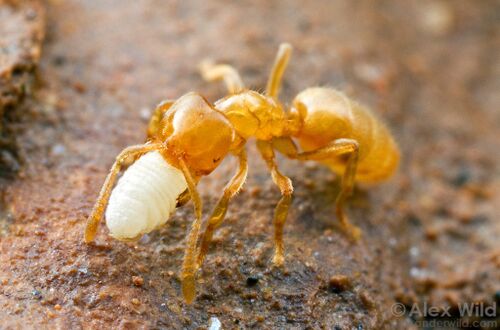Mealybug
Mealybugs are insects in the family Pseudococcidae, unarmored scale insects found in moist, warm climates.
Photo Gallery
 An Acropyga goeldii worker carries a mealybug. Viçosa, Minas Gerais, Brazil (image by Alex Wild).
An Acropyga goeldii worker carries a mealybug. Viçosa, Minas Gerais, Brazil (image by Alex Wild). Profile view of an Acropyga glaesaria paratype, carrying mealybug in mandibles.
Profile view of an Acropyga glaesaria paratype, carrying mealybug in mandibles.- Mating Acropyga epedana ants, the queen carrying a mealybug in her mandibles. Acropyga live nearly entirely by consuming secretions of root-feeding mealybugs, and the mealybugs depend on the ants for dispersal and protection. When young queen ants leave the nest to mate and start new colonies, they take a mealybug with them. Portal, Arizona, USA. Photo by Alex Wild.
Acropyga
Fossil specimens of genus Acropyga have been found in Dominican amber carrying the extinct mealybug genus Electromyrmococcus (Johnson et al., 2001). These fossils represent the oldest record of the symbiosis between mealybugs and Acropyga species.
Cladomyrma
A southeastern Asian genus, established colonies of Cladomyrma never lack sap-sucking scale insects inside their nest hollows, and the ants appear to be dependent on their honeydew excretions (Moog et al. 2005). Dissection of 338 founding chambers of eight Cladomyrma species showed that coccoid abundance strongly increases with founding age. The scale insects belong to a wide range of taxa, mainly Pseudococcidae. Coccidae are rare except in Cladomyrma maschwitzi.
List of Known Ant-Mealybug Associations
| Ant | Relationship | Mealybug | Locality | Source | Notes |
|---|---|---|---|---|---|
| Acropyga arnoldi | mutualist | Eumyrmococcus scorpioides | Africa | Prins, 1982; LaPolla & Spearman, 2007; Schneider & LaPolla, 2020 | |
| Acropyga ayanganna | mutualist | Neochavesia lapollai Williams | LaPolla & Schneider, 2023 | ||
| Acropyga epedana | mutualist | Rhizoecus colombiensis | Williams and LaPolla, 2004 | ||
| Acropyga exsanguis | mutualist | Geococcus coffeae | LaPolla (2004) | ||
| Acropyga exsanguis | mutualist | Neochavesia sp. | LaPolla (2004) | ||
| Acropyga exsanguis | mutualist | Pseudorhizoecus proximus | LaPolla (2004) | ||
| Acropyga exsanguis | mutualist | Rhizoecus caladii | LaPolla (2004) | ||
| Acropyga exsanguis | mutualist | Rhizoecus coffeae | Bünzli, 1935; Roba, 1936; LaPolla, 2004 | ||
| Acropyga exsanguis | mutualist | Rhizoecus falcifer | LaPolla (2004) | ||
| Acropyga glaesaria | mutualist | Electromyrmoccus abductus | Dominican Amber (Miocene) | ||
| Acropyga glaesaria | mutualist | Electromyrmoccus inclusus | Dominican Amber (Miocene) | ||
| Acropyga glaesaria | mutualist | Electromyrmoccus reginae | Dominican Amber (Miocene) | ||
| Acropyga manuense | mutualist | Neochavesia podexuta | LaPolla & Schneider, 2023 | ||
| Acropyga nipponensis | mutualist | Eumyrmococcus nipponensis | Japan | Terayama, 1985, 1986 | |
| Acropyga sauteri | mutualist | Eumyrmococcus smithii | Terayama, 1988; LaPolla, 2004 | ||
| Acropyga silvestrii | mutualist | Williamsrhizoecus udzungwensis | Tanzania | Schneider & LaPolla, 2020 | |
| Polyrhachis schellerichae | mutualist | Kermicus wroughtoni | Schellerich-Kaaden et al. 1997 |
References
- Johnson, M.S. et al. 2001. Acropyga and Azteca Ants (Hymenoptera: Formicidae) with Scale Insects (Sternorrhyncha: Coccoidea): 20 Million Years of Intimate Symbiosis. American Museum Novitates. 3335: 1–18 (doi:10.1206/0003-0082(2001)335<0001:AAAAHF>2.0.CO;2).
- Noe, Ronald (November 21, 2012). "Fire Ants Protect Mealybugs against Their Natural Enemies by Utilizing the Leaf Shelters Constructed by the Leaf Roller Sylepta derogata". US National Library of Medicine National Institutes of Health. PMC 3503828
| ||||||||||||||||||||||||||||||||||||||||||||||||||||||||

